Growing up fishing along the surf beach, I soon learnt to read the water and pick what structure will attract fish and where fishing would be a waste of time. Reading an estuary is not so simple. This is mainly due to the sheer size of most estuaries, however, they do have a lot of consistencies that can make them easy to read and can open a lot of fishing options.
I have recently moved from the Gold Coast where I have fished all my life and arrived at the mouth of three large river systems. At first it all looked rather daunting but I was soon to work out that looking for the similarities instead of the differences made locating fish a whole lot easier.
Having a glance at estuary in the dictionary and the meaning listed was “where the river meets the sea”. This meaning falls a little short because we anglers refer to all tidal reaches of a closed section of water as the estuary. This is often a river or creek but can also include inlets, broadwaters and basins.
Some estuaries are small rivers or creeks that run tidal through their entire length or they can be big systems feed by a number or rivers, creeks and inlets that also run tidal for the entire system. Bigger rivers and creeks usually have brackish water with reduced tidal flow towards to upper reaches that marks the boundary of what we refer to when talking about an estuary. In fact, most magazines that mention estuary fishing are referring to the lower reaches of the rivers, well before the water starts to turn brackish.
Up in the far north, we also see rivers that drain the wet season run-off and can run freshwater all the way to the mouth for most, if not all, of the year. These rivers are still slightly affected by tides, even if it is to slow their outgoing flow and, for all purposes, they appear and fish very similarly.
There are a lot of common features that most estuaries have so lets have a look at them and how locating them in your own local system can improve your fishing.
The mouth can be productive at certain times but it is more of the business centre of the system. This is where spawning takes place for a lot of fish and can be a real highway for both target species and baitfish that move in and out of the system.
A smaller system will generally fish a lot better from the mouth than larger ones. Small systems often see the change of tide fire up predators hunting baitfish, which are usually around the mouth. First and last light is also ideal especially for tailor, mulloway, queenfish and trevally.
Large systems with big breakwalls and strong tidal flows are a lot harder to fish. A lot of anglers specialise in certain species, like mulloway and luderick, from breakwalls but many hours of dedication is required to successfully fish these areas.
I call them secondary mouths because it is not the mouth of the river where it meets the open water but a lot of systems have creeks, canals or other rivers running off them that are a haven for species.
Secondary mouths have structure like weed beds, rock walls and drop-offs that can be very productive so have a good look at the secondary mouth and work out where the fish will be looking for a feed. Some mouths fire well on the run-out tide and others on the run in so it can sometimes take a few trips to work a spot out.
These spots are also ideal for live baiting for everything from trevally and flathead in the south to barra and queenfish in the north.
Most systems have rocks or walls of some kind. Most are man-made these days and are a haven for baitfish, crabs and growth, which attract predators.
The better rock walls are those that have access to deepwater and some current. Natural rock can often be in shallow water but scattered patches of rock are great for bream and flathead fishing in the south and ideal for barra in the north. These locations are sometimes overlooked because of the risk of snags but are worth a few pieces of lost tackle. Also look at fishing these shallow rock bars with poppers or shallow running lures.
Weed beds are a great fishing option because of the vast amount of food that they offer fish. High tide over the weed beds is a great option for flathead, bream, whiting, gar, mullet and even squid.
Weed is also often considered a hard location to fish but well worth the extra effort. Small sinkers are great but if you can mange to get away with no sinker at all, you will do extremely well.
Casting soft plastics at the bare patches of sand around weed beds can be extremely productive for bream and flathead.
Most anglers shy away from the snags for fear of getting caught up and losing tackle, but estuary guns go looking for snags to cast lures and bait into.
The snags that we are talking about here are usually fallen trees, mangrove roots or some other structure that protrudes from the shoreline into the water. Big fallen trees are ideal hiding holes for predatory fish to hold up out of the current and ambush anything that swims by. Mangrove jack, big bream, jewies, barra and cod are just a few of the regulars that hang in the snags.
It is no use casting a dead slab of squid or a piece of worm at a snag, instead live baits, fresh strips of oily fish like tuna or mullet and lures are what you need to bring a big predator out of his snag. It is very exciting fishing because the fish will want to head straight back into cover as soon as he is hooked. It is even more exciting to see a fish or a big flash of silver or red come out of a snag to belt a lure.
The only trick here is in getting close. If you don’t bump or get caught up on the snag from time to time, then you aren’t getting close enough.
Bridges, jetties, navigational beacons, pipes and signs are a few of the man-made structures that are worth having a look at when fishing. Structures have growth on them that brings food and makes a good hang out from the sun and current. Bream and mangrove jacks love the thousands of pontoons around the Gold and Sunshine Coast while everything from flathead to barra can be found hanging around beacons and bridges.
The idea is to get your bait drifting down near the structure or if there is shade created from the structure, casting to the shadows is your best bet.
Fast moving water from current has a lot of momentum so when a current hits an underwater obstruction or variation, it can change the direction of that flow. This appears as a small whirlpool type pattern on the surface of the water, which is referred to as an eddie. At first, eddies appear to be structureless but it is some sort of underwater structure forming the eddie.
Big eddies hold fish for two reasons. Firstly, the structure that caused the eddie is well worth a look. It can be a deep hole, ledge, rock bar or even a wreck. I found a great little pipeline in a river a little north of my home and it is such a good fishing spot that I am kicking myself for driving past the eddie it created for so many years without checking it out. I now try and investigate the cause for all big eddies that I find.
Secondly, baitfish that are moving through a system seem to get disorientated by the change in current flow and appear to be caught up in these eddies.
Eddies fish a little bit like a snag; you would be selling yourself short to drop a small bait into a big eddie. Live baits are perfect and to give you some idea, my brother often fishes big eddies with 30-40cm live mullet as bait for big jewies and sharks.
So many little things in the water can attract fish so it is all about keeping an eye out. Look at how the current works around corners and interacts with various structures.
Fishing a barren looking bank can be unproductive but a similar looking bank at high tide that is loaded with yabbie and crab holes may be a great option for bream and whiting.
A small stretch of beach or riverbank can often hold a lot of options if you keep your eyes open and understand how fish use structure.
Reads: 3811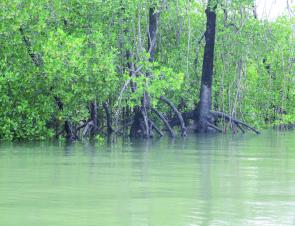
Most anglers shy away from the snags for fear of getting caught up and losing tackle, but estuary guns go looking for snags to cast lures and bait into.
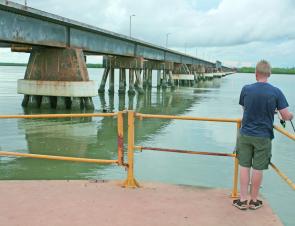
Man-made structures, such as this bridge, have growth on them that brings food and makes a good hang out from the sun and current for the fish.
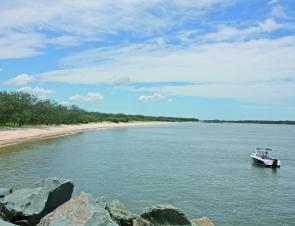
Wave Break Island in the Gold Coast Broadwater is a great case and point for structure. The rock walls at each end have seen plenty of quality fish caught but the sandy, structureless beach yields little more then toad fish.
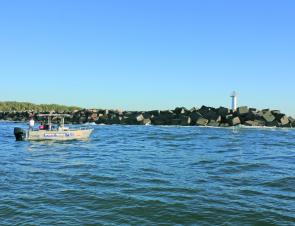
Breakwalls are not easy to fish but can produce from huge fish for those with the patients and knowledge to work them.
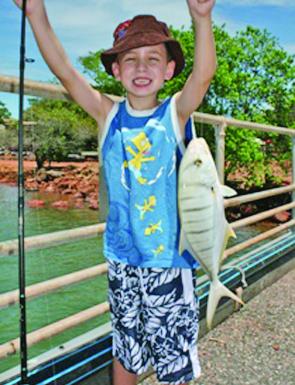
Young Cody Ward with a nice little golden trevally he landed from a jetty up in Weipa.




